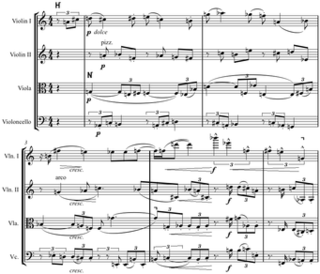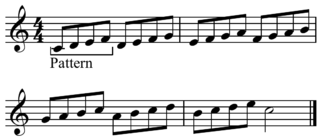 W
WA melody, also tune, voice or line, is a linear succession of musical tones that the listener perceives as a single entity. In its most literal sense, a melody is a combination of pitch and rhythm, while more figuratively, the term can include successions of other musical elements such as tonal color. It may be considered the foreground to the background accompaniment. A line or part need not be a foreground melody.
 W
WThe balungan is sometimes called the "core melody" or, "skeletal melodic outline," of a Javanese gamelan composition. This corresponds to the view that gamelan music is heterophonic: the balungan is then the melody which is being elaborated. "An abstraction of the inner melody felt by musicians," the balungan is, "the part most frequently notated by Javanese musicians, and the only one likely to be used in performance."
 W
WIn music, a counter-melody is a sequence of notes, perceived as a melody, written to be played simultaneously with a more prominent lead melody. In other words, it is a secondary melody played in counterpoint with the primary melody. A counter-melody performs a subordinate role, and it is typically heard in a texture consisting of a melody plus accompaniment.
 W
WA musical figure or figuration is the shortest phrase in music; a short succession of notes, often recurring. It may have melodic pitch, harmonic progression, and rhythmic meter. The 1964 Grove's Dictionary defines the figure as "the exact counterpart of the German 'motiv' and the French 'motif'": it produces a "single complete and distinct impression". To the self-taught Roger Scruton, however, a figure is distinguished from a motif in that a figure is background while a motif is foreground:A figure resembles a moulding in architecture: it is 'open at both ends', so as to be endlessly repeatable. In hearing a phrase as a figure, rather than a motif, we are at the same time placing it in the background, even if it is ... strong and melodious
 W
WIn music, Hauptstimme or Hauptsatz is the main voice, chief part; i.e., the contrapuntal or melodic line of primary importance, in opposition to Nebenstimme. Nebenstimme or Seitensatz is the secondary part; i.e., a secondary contrapuntal or melodic part, always occurring simultaneously with, and subsidiary to, the Hauptstimme. The practice of marking the primary voice within the musical score/parts was invented by Arnold Schoenberg.
 W
WIn music and jazz improvisation, a melodic pattern is a cell or germ serving as the basis for repetitive pattern. It is a figure that can be used with any scale. It is used primarily for solos because, when practiced enough, it can be extremely useful when improvising. "Sequence" refers to the repetition of a part at a higher or lower pitch, and melodic sequence is differentiated from harmonic sequence. One example of melodic motive and sequence are the pitches of the first line, "Send her victorious," repeated, a step lower, in the second line, "Happy and glorious," from "God Save the Queen".
 W
WIn music, a motif (pronunciation) (help·info) is a short musical phrase, a salient recurring figure, musical fragment or succession of notes that has some special importance in or is characteristic of a composition: "The motive is the smallest structural unit possessing thematic identity".
 W
WA part generally refers to a single strand or melody or harmony of music within a larger ensemble or a polyphonic musical composition. There are several senses in which the word is often used:the physical copy of printed or written sheet music given to any individual instrument or voice. A musician's part usually does not contain instructions for the other players in the ensemble, only instructions for that individual. the music played by any group of musicians who all perform in unison for a given piece; in a symphony orchestra, a dozen or more cello players may all play "the same part" even if they each have their own physical copy of the music. This sense of "part" does not require a written copy of the music; a bass player in a rock band "plays the bass part" even if there is no written version of the song. any individual melody that can be abstracted as continuous and independent from other notes being performed simultaneously. Within the music played by a single pianist, one can often identify outer parts or an inner part. On the other hand, within a choir, "outer parts" and "inner parts" would refer to music performed by different people. See the section Polyphony and Part-writing below. a section in the large-scale form of a piece. See the section Musical form below.
 W
WIn music, a step, or conjunct motion, is the difference in pitch between two consecutive notes of a musical scale. In other words, it is the interval between two consecutive scale degrees. Any larger interval is called a skip, or disjunct motion.
 W
WIn music, a subject is the material, usually a recognizable melody, upon which part or all of a composition is based. In forms other than the fugue, this may be known as the theme.
 W
WIn Schenkerian analysis, unfolding or compound melody is the implication of more than one melody or line by a single voice through skipping back and forth between the notes of the two melodies. In music cognition, the phenomenon is also known as melodic fission.